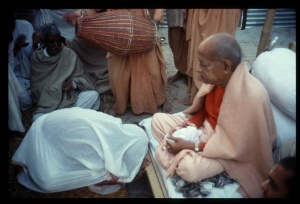CC Madhya 5.141: Difference between revisions
m (1 revision(s)) |
No edit summary |
||
| Line 1: | Line 1: | ||
{{ | [[Category:Sri Caitanya-caritamrta - Madhya-lila Chapter 05|C141]] | ||
<div style="float:left">'''[[Sri Caitanya-caritamrta|Śrī Caitanya-caritāmṛta]] - [[CC Madhya|Madhya-līlā]] - [[CC Madhya 5|Chapter 5: The Activities of Sākṣi-gopāla]]'''</div> | |||
<div style="float:right">[[File:Go-previous.png|link=CC Madhya 5.140|Madhya-līlā 5.140]] '''[[CC Madhya 5.140|Madhya-līlā 5.140]] - [[CC Madhya 5.142-143|Madhya-līlā 5.142-143]]''' [[File:Go-next.png|link=CC Madhya 5.142-143|Madhya-līlā 5.142-143]]</div> | |||
{{CompareVersions|CC|Madhya 5.141|CC 1975|CC 1996}} | |||
{{RandomImage}} | |||
==== TEXT 141 ==== | ==== TEXT 141 ==== | ||
<div | <div class="verse"> | ||
kamalapure āsi bhārgīnadī-snāna kaila | :kamalapure āsi bhārgīnadī-snāna kaila | ||
nityānanda-hāte prabhu daṇḍa dharila | :nityānanda-hāte prabhu daṇḍa dharila | ||
</div> | </div> | ||
| Line 12: | Line 16: | ||
==== SYNONYMS ==== | ==== SYNONYMS ==== | ||
<div | <div class="synonyms"> | ||
kamala-pure—to the place known as Kamalapura; | ''kamala''-pure—to the place known as Kamalapura; ''āsi''—coming; ''bhārgī-nadī''—in the small river of the name Bhārgīnadī; snāna kaila—took a bath; ''nityānanda''-hāte—in the hands of Lord Nityānanda Prabhu; ''prabhu''—Lord Śrī Caitanya Mahāprabhu; ''daṇḍa—the'' sannyāsa staff; ''dharila''—left. | ||
</div> | </div> | ||
| Line 19: | Line 23: | ||
==== TRANSLATION ==== | ==== TRANSLATION ==== | ||
<div | <div class="translation"> | ||
When Śrī Caitanya Mahāprabhu arrived at Kamalapura, He took His bath in the Bhārgīnadī River and left His sannyāsa staff in the hands of Lord Nityānanda. | When Śrī Caitanya Mahāprabhu arrived at Kamalapura, He took His bath in the Bhārgīnadī River and left His sannyāsa staff in the hands of Lord Nityānanda. | ||
</div> | </div> | ||
| Line 26: | Line 30: | ||
==== PURPORT ==== | ==== PURPORT ==== | ||
<div | <div class="purport"> | ||
In the Caitanya-bhāgavata (Antya-khaṇḍa, Chapter Two) it is said that when Lord Śrī Caitanya Mahāprabhu arrived at Śrī Bhuvaneśvara, He visited the temple of Lord Śiva known as Gupta-kāśī (the concealed Vārāṇasī). Lord Śiva established this as a place of pilgrimage by bringing water from all holy places and creating the lake known as Bindu-sarovara. Śrī Caitanya Mahāprabhu took His bath in this lake, feeling a great regard for Lord Śiva. From the spiritual point of view, people still go to take a bath in this lake. Actually, by taking a bath there, one becomes very healthy even from the material viewpoint. Taking a bath and drinking the water of this lake can cure any disease of the stomach. Regular bathing certainly cures indigestion. The river Bhārgī, or Bhārgīnadī, came to be known as the Daṇḍa-bhāṅgā-nadī after Lord Caitanya bathed in its waters. It is situated six miles north of Jagannātha Purī. The reason for the change in names is given as follows. | In the ''Caitanya-bhāgavata'' (''Antya-khaṇḍa,'' Chapter Two) it is said that when Lord Śrī Caitanya Mahāprabhu arrived at Śrī Bhuvaneśvara, He visited the temple of Lord Śiva known as Gupta-kāśī (the concealed Vārāṇasī). Lord Śiva established this as a place of pilgrimage by bringing water from all holy places and creating the lake known as Bindu-sarovara. Śrī Caitanya Mahāprabhu took His bath in this lake, feeling a great regard for Lord Śiva. From the spiritual point of view, people still go to take a bath in this lake. Actually, by taking a bath there, one becomes very healthy even from the material viewpoint. Taking a bath and drinking the water of this lake can cure any disease of the stomach. Regular bathing certainly cures indigestion. The river Bhārgī, or Bhārgīnadī, came to be known as the Daṇḍa-bhāṅgā-nadī after Lord Caitanya bathed in its waters. It is situated six miles north of Jagannātha Purī. The reason for the change in names is given as follows. | ||
</div> | </div> | ||
__NOTOC__ | |||
<div style="float:right; clear:both;">[[File:Go-previous.png|link=CC Madhya 5.140|Madhya-līlā 5.140]] '''[[CC Madhya 5.140|Madhya-līlā 5.140]] - [[CC Madhya 5.142-143|Madhya-līlā 5.142-143]]''' [[File:Go-next.png|link=CC Madhya 5.142-143|Madhya-līlā 5.142-143]]</div> | |||
__NOTOC__ | |||
__NOEDITSECTION__ | |||
Revision as of 11:08, 28 July 2021

A.C. Bhaktivedanta Swami Prabhupada
TEXT 141
- kamalapure āsi bhārgīnadī-snāna kaila
- nityānanda-hāte prabhu daṇḍa dharila
SYNONYMS
kamala-pure—to the place known as Kamalapura; āsi—coming; bhārgī-nadī—in the small river of the name Bhārgīnadī; snāna kaila—took a bath; nityānanda-hāte—in the hands of Lord Nityānanda Prabhu; prabhu—Lord Śrī Caitanya Mahāprabhu; daṇḍa—the sannyāsa staff; dharila—left.
TRANSLATION
When Śrī Caitanya Mahāprabhu arrived at Kamalapura, He took His bath in the Bhārgīnadī River and left His sannyāsa staff in the hands of Lord Nityānanda.
PURPORT
In the Caitanya-bhāgavata (Antya-khaṇḍa, Chapter Two) it is said that when Lord Śrī Caitanya Mahāprabhu arrived at Śrī Bhuvaneśvara, He visited the temple of Lord Śiva known as Gupta-kāśī (the concealed Vārāṇasī). Lord Śiva established this as a place of pilgrimage by bringing water from all holy places and creating the lake known as Bindu-sarovara. Śrī Caitanya Mahāprabhu took His bath in this lake, feeling a great regard for Lord Śiva. From the spiritual point of view, people still go to take a bath in this lake. Actually, by taking a bath there, one becomes very healthy even from the material viewpoint. Taking a bath and drinking the water of this lake can cure any disease of the stomach. Regular bathing certainly cures indigestion. The river Bhārgī, or Bhārgīnadī, came to be known as the Daṇḍa-bhāṅgā-nadī after Lord Caitanya bathed in its waters. It is situated six miles north of Jagannātha Purī. The reason for the change in names is given as follows.